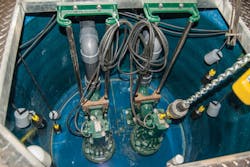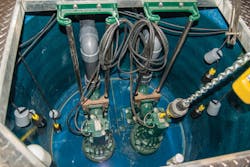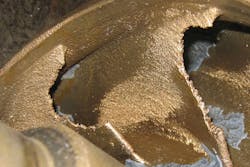Suction Head, Cavitation, and Submersible Pumps
By Darren E. Meyers, P.E.
Perhaps one of the strangest concepts for pump industry professionals to understand is Net Positive Suction Head (NPSH). Even the phrase itself is clunky and difficult to decipher. For many of the most common pumping applications in the world - those involving submersible pumps - NPSH is a non-issue completely. But, in certain applications, proper consideration of NPSH is critical to the long-term success of a system, and it is important that all pump system and process engineers have a thorough grasp on the concept.
This article will outline a basic understanding of NPSH and will identify the applications in which its consideration is - and is not - important. For simplicity, we’ll assume from this point forward that we are only dealing with water or sewage, not some other chemical or fluid.
Before we can begin to understand a concept like NPSH, we must first understand the notion of cavitation. Some people believe, incorrectly, that cavitation happens when air gets drawn into the pump intake. This condition is actually called air entrainment, not cavitation. While air entrainment is also a serious matter and should be avoided, it is a completely separate issue for another time.
Cavitation is a phase reaction that can happen inside of a pump housing near the impeller if the pressure of the pumped liquid drops below a certain critical value. If these critical conditions are met, the liquid will flash instantly into little bubbles, or “cavities” of water vapor just like it does in a pot of boiling water. As the fluid continues through the pump housing, the pressure increases, causing these little vapor bubbles to violently collapse back down into liquid. The transition from liquid to vapor and back to liquid typically happens within a fraction of a second, but the cumulative effects of these reactions over time can cause not only a loss of pump efficiency but also considerable physical damage. Since cavitation is literally thousands of little explosions and implosions inside the pump, these reactions can actually blast pits into the impeller and pump housing sidewalls, thereby eroding the components and shortening the pump’s life considerably. The resulting turbulence also causes vibrations that are detrimental not only to the pump’s seals and bearings but also to the surrounding system components. In short, cavitation is very destructive.
Preventing Cavitation
At this point, we are better prepared to discuss NPSH. As mentioned earlier, in order for cavitation to occur inside of a pump housing, the pressure of the pumped fluid must drop below a certain critical value, known as the vapor pressure. Many different factors affect the pressure of the fluid inside the pump housing, the most important of which are water temperature, wet well water depth, suction piping (if present), discharge pressure, and pump inlet geometry. Water temperature, depth, suction piping, and discharge pressure are all characteristics that can be manipulated by the project’s engineers. However, the geometry of different pump inlets varies from one pump manufacturer to the next. In order to allow design engineers to run cavitation calculations, certain pump manufacturers publish Net Positive Suction Head Required (NPSHR) values. These values establish the minimum pressure that the fluid can be just before entering the pump to ensure that the liquid doesn’t drop below vapor pressure inside and begin to cavitate. Design engineers can look at all the other characteristics of the system around the pump and can then figure the Net Positive Suction Head Available (NPSHA). As long as the available NPSH is greater than the required NPSH, then the liquid in the system will not cavitate.
As an engineer with a pump company, I get calls periodically from customers looking for NPSHR information on our pumps. A look through our published literature reveals no mention whatsoever of NPSHR values. The same is true of most of our fellow submersible pump manufacturers. Considering the importance of avoiding cavitation, why would we and others omit such vital information? The answer lies in the kinds of applications in which our pumps are used. As we learned above, one of the key factors affecting cavitation in pumps is suction piping. With a few notable exceptions, cavitation in pumps is almost always linked to systems involving suction-side piping, such as one might find in a dry pit pumping application. As water is drawn through these suction pipes en route to the pump, friction losses cause the fluid pressure to drop. If it drops low enough to reach the vapor pressure, cavitation will result. When submersible pumps are lowered directly into a wet well, there is no suction-side piping routing water to the pump’s inlet. For pumps applied almost exclusively in wet well applications without suction piping, the potential for cavitation is virtually non-existent. As long as the pump is designed and allowed to operate on its published curve; the water temperature falls within the manufacturer’s allowable range; and the wet well is sufficiently vented so as not to create a vacuum as the fluid level drops, then the liquid pressure in the pump housing will not drop low enough for cavitation to occur.
About the Author: Darren E. Meyers, P.E., is an application engineer with Zoeller Company (www.zoeller.com).
More WaterWorld Current Issue Articles
More WaterWorld Archives Issue Articles


